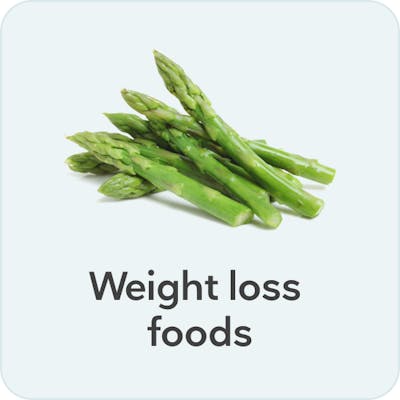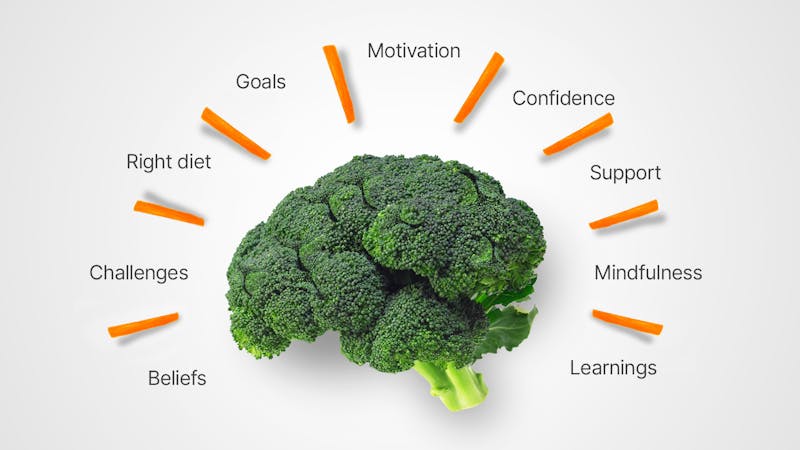Weight loss and resting metabolic rate
Evidence based
Three key takeaways
Know your resting metabolic rateYour resting metabolic rate (RMR) accounts for the majority of your daily energy expenditure. Learn more
Maintain and improve your RMR
Eating adequate or high protein and doing resistance exercise regularly are fundamental for a healthy RMR. Here’s why
RMR is the key to long-term success
Lowering your RMR through crash dieting makes long-term weight maintenance much more challenging. Here’s why
What’s one of the biggest secrets to maintaining weight loss long term?
It’s maintaining your resting metabolic rate (RMR), sometimes called your basal metabolism.
Your RMR is the number of calories you burn daily to sustain your body’s normal functions — basics like breathing, pumping blood in your circulation, brain activity, and cellular functions.
Unfortunately, some forms of weight loss can reduce your RMR, which makes it difficult to maintain your weight loss.1
In this guide, we show you how to protect your metabolic rate while losing weight in a healthy way.
Spoiler alert: There is one main principle to remember if you want to improve your chances of protecting your RMR with weight loss:
- Build or maintain lean mass by eating adequate protein and doing resistance training.


What is resting metabolic rate?
Your resting metabolic rate is the amount of energy, or calories needed to sustain your body’s basic functions for 24 hours.
RMR is similar to basal metabolic rate (BMR), and these terms are often used interchangeably — although they are not exactly the same. For this guide, we will use RMR.
How to calculate resting metabolic rate
For an accurate assessment of your RMR, you can have it measured with a specialized test called indirect calorimetry.2
You can learn more about indirect calorimetry in our podcast with metabolism expert Kirsty Woods.
While indirect calorimetry is the gold standard for measuring your resting metabolic rate, it can be expensive and isn’t widely available. Unfortunately, there aren’t any inexpensive, at-home ways to precisely measure RMR. The next best alternative is to estimate RMR.
How to estimate resting metabolic rate
There are various calculators you can use to estimate your RMR. As with many calculators, these are general guides and not entirely accurate.3 They’re based on equations that are imperfect for individuals but fairly accurate when looking at averages in large groups of people.
To give you an idea of your RMR, we’ve illustrated these estimates using the Revised Harris-Benedict BMR equation, for four different body sizes for both men and women:
Women
| 20yo | 30yo | 40yo | 50yo | 60yo | 70yo | |
|---|---|---|---|---|---|---|
| 5’4” (162 cm), 130 pounds (59 kilos) | 1,409 | 1,365 | 1,322 | 1,279 | 1,235 | 1,192 |
| 5’4” (162 cm), 200 pounds (91 kilos) | 1,695 | 1,651 | 1,608 | 1,565 | 1,521 | 1,478 |
| 5’7” (170 cm), 155 pounds (70 kilos) | 1,535 | 1,491 | 1,448 | 1,405 | 1,351 | 1,318 |
| 5’7” (170 cm), 225 pounds (102 kilos) | 1,831 | 1,787 | 1,744 | 1,701 | 1,647 | 1,614 |
Estimated RMR (in calories) by age using the Revised Harris-Benedict BMR equation
Men
| 20yo | 30yo | 40yo | 50yo | 60yo | 70yo | |
|---|---|---|---|---|---|---|
| 5’7” (170 cm), 160 pounds (73 kilos) | 1,756 | 1,699 | 1,642 | 1,585 | 1,529 | 1,472 |
| 5’7” (170 cm), 220 pounds (100 kilos) | 2,131 | 2,074 | 2,017 | 1,960 | 1,904 | 1,847 |
| 5’11” (180 cm), 190 pounds (86 kilos) | 1,991 | 1,934 | 1,877 | 1,820 | 1,764 | 1,707 |
| 5’11” (180 cm), 250 pounds (114 kilos) | 2,353 | 2,296 | 2,239 | 2,182 | 2,124 | 2,069 |
Estimated RMR (in calories) by age using the Revised Harris-Benedict BMR equation
If you’d like to calculate RMR for your particular age and size, here is the formula behind the above estimates:
Revised Harris-Benedict BMR equation
- Men: 88.4 + (13.4 x weight in kilos) + (4.8 x height in cm) – (5.68 x age in years)
- Women: 447.6 + (9.25 x weight in kilos) + (3.10 x height in cm) – (4.33 x age in years)
Some people like to calculate RMR using more than formula, for comparison purposes, as different formulas have been shown to over- or underestimate RMR under different circumstances.4 A detailed discussion of the advantages and disadvantages of each formula is outside the scope of this guide, but here is an alternative formula you can try:
Mifflin-St Jeor equation
- Men: (9.99 x weight in kilos) + (6.25 x height in cm) – (4.92 x age in years) + 5
- Women: (9.99 x weight in kilos) + (6.25 x height in cm) – (4.92 x age in years) – 161
How do you improve your resting metabolic rate?
Some of the factors affecting your resting metabolic rate are outside of your control — such as your biologic sex, age, height, and genetics. However, other factors are within your control — such as weight and body composition.
Losing weight can decrease RMR, but losing weight in a healthy way by maintaining lean mass and losing mostly fat mass helps counteract this reduction.5 You can help maintain or even build lean mass by eating an adequate- or high-protein diet and doing resistance training regularly.6
As we detail in our guides on exercise and health and how to improve your body composition, resistance training is the clear winner for building lean muscle mass. Cardio exercise may provide other benefits, like improvement in cardiorespiratory fitness and calorie expenditure (which can lead to fat loss if appetite remains in check), but it’s unlikely to help you build muscle like resistance training will.
Studies have also shown that low-carb diets can help people lose mostly fat mass while maintaining both lean mass and resting metabolic rate.7 However, it’s important to note that in many trials the low-carb diet group also tends to eat more protein. So, it may be more accurate to say the data support that a lower-carb, higher-protein diet can help maintain RMR.
To learn more about starting a low-carb diet, we have a great resource: A low-carb diet for beginners.
Some foods, such as coffee, green tea, and capsaicin (the compound that makes some foods spicy, like chili peppers), can reportedly improve metabolism or RMR. However, the data supporting these claims are weak and they are likely not good choices for improving your RMR. You can read more in our guide on fat-burning foods.
Why does resting metabolic rate matter?
Resting metabolic rate is important if you want to know how much to eat to maintain a calorie balance or deficit.
To lose weight you need your daily energy expenditure to be higher than your calorie intake. That doesn’t mean you have to count calories. With low-carb, higher-protein diets, people tend to naturally eat fewer calories without counting them. This is due, at least in part, to the satiety effect of protein.
However, when people are struggling to lose weight or hitting plateaus they can’t break through, it can be helpful to make sure that calorie intake is less than total daily energy expenditure.
But losing weight with a calorie-restricted diet can be a problem if RMR decreases significantly with weight loss.
RMR tends to go down with weight loss, particularly as lean body mass is lost. However, RMR often drops even further than what would be predicted based on how much lean tissue is lost. This is called metabolic adaptation and has led many researchers to speculate that this extra decline is part of the body’s natural defense mechanism to prevent further weight loss.8
A study of the contestants from The Biggest Loser TV show demonstrated that the aggressive “eat less, move more” approach resulted in a substantial and lasting reduction to participants’ RMR.9 Six years after the show ended, many of the contestants regained most of their lost weight, and their average RMR was 500 calories per day less than expected, based on their measured body composition and increased age. That is a disastrous combination for long-term healthy weight loss.
The majority of your daily energy expenditure comes from your RMR. Exercise expends energy, but usually only a small percentage of total daily calories.10 For example, if your RMR is 1,500 calories, and your physical activity burns another 300 calories (roughly the equivalent of walking three or four miles for the average person), your RMR makes up 83% of your 1,800 calorie daily energy expenditure.
In the above example, you need to eat less than 1,800 calories to maintain a calorie deficit.11
But what happens to your RMR if you lose 40 pounds?
If a 5 ft. 5 in. (165 cm) 50-year old woman who weighs 200 pounds (91 kilos) loses 40 pounds in a manner that doesn’t protect RMR, her RMR will go from 1,583 calories per day to 1,417 calories per day using the Harris-Benedict equation. All of a sudden, she needs to cut 166 calories out of her daily meals just to maintain her weight.
On the other hand, if she’s able to maintain her RMR at 1,583 calories per day during weight loss, she won’t have to worry about cutting any calories from her diet; she can continue to eat 1,800 calories (assuming 1,583 RMR + 217 physical activity) while remaining weight-stable.
Even if you don’t count calories, the concept is still important. If your RMR goes down, you’ll have a harder time maintaining weight loss. You can improve your chances of succeeding long-term by either maintaining RMR or preserving as much of it as possible.
Is rapid weight loss always bad for my resting metabolic rate?
The results from the Biggest Loser study may give the impression that rapid weight loss always leads to poor long-term success. Interestingly, studies examining slow versus fast initial weight loss have produced contradictory results, with some suggesting slow and steady wins the race and others showing that rapid loss leads to greater and more sustained weight loss.12
The existing evidence is inconclusive with respect to why some people experience greater success with slow or fast initial weight loss. Rapid up-front loss can be reinforcing and encouraging, while a slow rate of loss might be less likely to cause significant metabolic adaptation. Because this is all speculative, we believe the best path is to focus on healthy weight loss, rather than weight loss at any cost.
Healthy weight loss protects your resting metabolic rate
We can’t say it enough: we believe weight loss, per se, should not be your ultimate goal. Instead, healthy weight loss should take center stage.
One crucial aspect of healthy weight loss is protecting your RMR.
The traditional “eat less, move more” approach to weight loss often leads to reduced RMR, which means it often leads to unhealthy and unsustainable weight loss.
Eating low-carb, higher-protein foods, combined with regular resistance training, is a great start to maintaining your RMR. This can set you up for success with long-term healthy weight loss.
Weight loss and resting metabolic rate - the evidence
This guide is written by Dr. Bret Scher, MD and was last updated on October 17, 2022. It was medically reviewed by Dr. Michael Tamber, MD on December 1, 2021.
The guide contains scientific references. You can find these in the notes throughout the text, and click the links to read the peer-reviewed scientific papers. When appropriate we include a grading of the strength of the evidence, with a link to our policy on this. Our evidence-based guides are updated at least once per year to reflect and reference the latest science on the topic.
All our evidence-based health guides are written or reviewed by medical doctors who are experts on the topic. To stay unbiased we show no ads, sell no physical products, and take no money from the industry. We're fully funded by the people, via an optional membership. Most information at Diet Doctor is free forever.
Read more about our policies and work with evidence-based guides, nutritional controversies, our editorial team, and our medical review board.
Should you find any inaccuracy in this guide, please email andreas@dietdoctor.com.
PLoS One 2009: Metabolic and behavioral compensations in response to caloric restriction: implications for the maintenance of weight loss
[randomized trial; moderate evidence]Nutrition and Metabolism 2021: Metabolic adaptation is associated with less weight and fat mass loss in response to low-energy diets [randomized trial; moderate evidence]
↩Metabolism 1988: The theoretical bases of indirect calorimetry: a review
[overview article; ungraded] ↩Nutrition and metabolism 2018: Estimating the agreement between the metabolic rate calculated from prediction equations and from a portable indirect calorimetry device: an effort to develop a new equation for predicting resting metabolic rate [non-controlled study; weak evidence] ↩
Journal of the American Dietetic Association 2005: Comparison of predictive equations for resting metabolic rate in healthy nonobese and obese adults: a systematic review [systematic review of RCTs and observational studies; moderate evidence] ↩
Asia Pacific Journal of Clinical NUtrition 2001: New approach for weight reduction by a combination of diet, light resistance exercise and the timing of ingesting a protein supplement [randomized trial; moderate evidence]
Obesity 2012: Resistance Training Conserves Fat-free Mass and Resting Energy Expenditure Following Weight Loss [randomized trial; moderate evidence] ↩
JAMA 2012: Effect of dietary protein content on weight gain, energy expenditure, and body composition during overeating: a randomized controlled trial
[randomized trial; moderate evidence]Nutrition and Metabolism 2014: A high-protein diet for reducing body fat: mechanisms and possible caveats [overview article; ungraded]
Journal of Obseity 2011: Evidence for resistance training as a treatment therapy in obesity [overview article; ungraded] ↩
Nutrition and Metabolism 2018: Resting metabolic rate of obese patients under very low calorie ketogenic diet [non-controlled study; weak evidence]
Journal of Clinical Endocrinology and Metabolism 2017: Body composition changes after very-low-calorie ketogenic diet in obesity evaluated by 3 standardized methods[non-controlled study; weak evidence]
This trial showed that total energy expenditure increased by about 50 calories/day for every 10% decrease in the contribution of carbohydrate intake to total daily energy intake. On average, the low-carb group burned about 200 more calories per day than the high-carb group.
BMJ 2018: Effects of a low carbohydrate diet on energy expenditure during weight loss maintenance: randomized trial [randomized trial; moderate evidence] ↩
PLoS One 2009: Metabolic and behavioral compensations in response to caloric restriction: implications for the maintenance of weight loss [randomized trial; moderate evidence]
Family Practice 1999: Effects of dieting and exercise on resting metabolic rate and implications for weight management [overview article; ungraded]
↩Obesity 2016: Persistent metabolic adaptation 6 years after “The Biggest Loser” competition[non-controlled study; weak evidence] ↩
PLoS One 2012: Hunter-Gatherer Energetics and Human Obesity[non-controlled study; weak evidence]
Family Practice 1999: Effects of dieting and exercise on resting metabolic rate and implications for weight management [overview article; ungraded]
↩Maintaining a calorie deficit may be important for weight loss, but it definitely is not the only important consideration. We suggest you also need to maintain muscle mass and pay attention to the other components of healthy weight loss. You can read more in our dedicated guide on healthy weight loss. ↩
Annals of Behavioral Medicine 2008: Small changes in nutrition and physical activity promote weight loss and maintenance: 3-month evidence from the ASPIRE randomized trial[randomized trial; moderate evidence]
International Journal of Behavioral Medicine 2010: The association between rate of initial weight loss and long-term success in obesity treatment: does slow and steady win the race? [non-controlled study; weak evidence]
Obesity Reviews 2000: Lessons from obesity management programmes: greater initial weight loss improves long-term maintenance [overview article; ungraded]
↩








